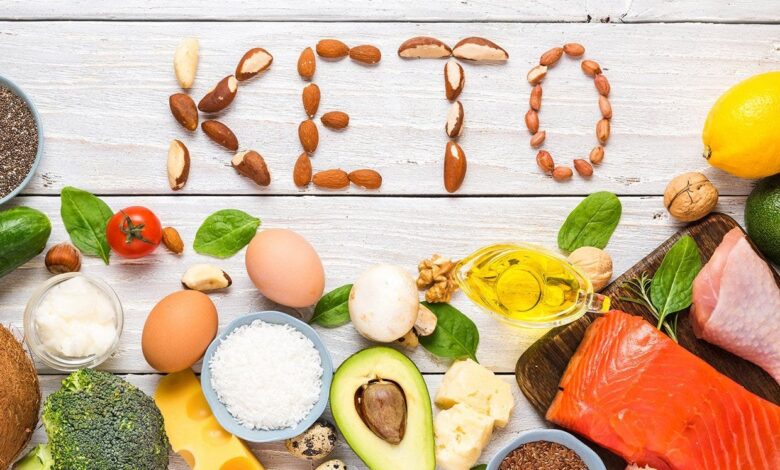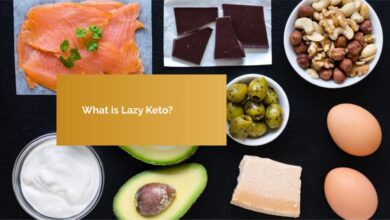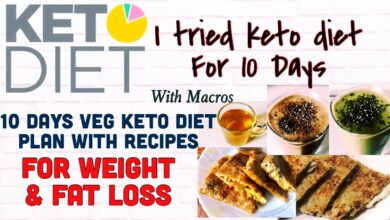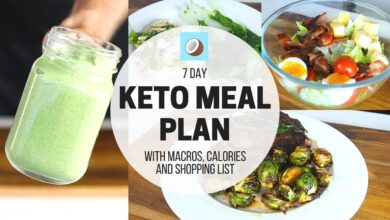
1. 10 Fruits for a Keto Diet
2. Introduction
- Defining the keto diet and its principles
- Common misconceptions about fruits on keto
- Why certain fruits fit well into a keto lifestyle
- Ketogenic Diet Basics
- What is ketosis?
- Macronutrient ratios and daily carbohydrate limits
- Why low-carb matters for sustained ketosis
- Key Considerations for Fruits on Keto
- Understanding net carbs vs. total carbs
- Importance of glycemic impact and fiber
- Balancing micronutrients without spiking blood sugar
- Fruit #1: Avocado
- Nutrient profile and healthy fats
- Fiber content and net carb calculation
- Ways to incorporate avocado into keto meals
- Fruit #2: Olives
- Why olives are technically fruits
- Monounsaturated fats and anti-inflammatory benefits
- Low net carb counts for keto success
- Fruit #3: Tomatoes
- Carb counts and glycemic load
- Antioxidants and vitamins for immune support
- Creative keto-friendly recipes with tomatoes
- Fruit #4: Cucumbers
- High water content for hydration
- Minimal net carbs and fiber benefits
- Ideas for keto cucumber snacks and meals
- Fruit #5: Bell Peppers
- Vitamin C powerhouse with limited carbs
- Varieties of bell peppers and their carb profiles
- Keto-friendly ways to use bell peppers in cooking
- Fruit #6: Zucchini
- Versatile “fruit” with low net carbs
- Zucchini noodles and other keto hacks
- Pairing zucchini with healthy fats for better meals
- Fruit #7: Eggplant
- Fiber-rich and moderate carb content
- Antioxidants and their role in overall health
- Keto eggplant dishes and cooking methods
- Fruit #8: Strawberries
- Net carbs, sugar content, and portion control
- Antioxidants, vitamins, and polyphenols
- Tips for enjoying strawberries without breaking ketosis
- Fruit #9: Raspberries
- Balancing sweetness and carb limits
- High fiber content for net carb reduction
- Keto-friendly desserts and snack ideas
- Fruit #10: Blackberries
- Low net carbs and robust antioxidant profile
- Using blackberries in keto breakfast and dessert
- Pairing blackberries with healthy fats for satiety
- Tips for Selecting and Storing Keto-Friendly Fruits
- Buying fresh vs. frozen produce
- Storage techniques to preserve nutrients
- Net carb tracking and portion guidance
- Complementary Lifestyle Habits for Keto Success
- Hydration and electrolyte balance
- The importance of quality sleep for metabolism
- Exercise routines to complement keto fruit intake
- Potential Pitfalls and Mistakes on Keto
- Overeating fruit sugars and stalling ketosis
- Ignoring hidden carbs in fruit-based products
- Balancing fruit intake with protein and fat macros
- Conclusion
- FAQs
- How many fruits can I eat per day on keto?
- Are fruit juices keto-friendly?
- Can I eat fruits other than the ones listed here?
- What if I go over my carb limit with fruit?
- Is it okay to eat fruit during early keto?
10 Fruits for a Keto Diet
When you think about the keto diet, the first images that might pop into your mind are sizzling bacon, creamy avocado, and maybe a big chunk of butter. But fruit? That’s usually one of the first food groups people assume they have to avoid entirely. Surprisingly, not all fruits are off-limits on a ketogenic lifestyle. In fact, certain fruits can fit comfortably into your low-carb plan if you choose them wisely and keep your portions in check.
In this in-depth guide, we’ll explore 10 fruits that can be enjoyed on the keto diet without causing massive carb spikes. You’ll learn what makes these fruits “keto-friendly,” how to incorporate them into your meal plan, and the key benefits they offer for both your health and your palate. So, if you’re ready to add a touch of natural sweetness back into your keto journey, let’s dive right in!
Introduction;

Maintaining ketosis requires careful monitoring of carbohydrates. Many people assume that fruit is a big no-no when counting carbs because it’s often high in natural sugars. However, some fruits deliver a variety of health benefits—like vitamins, antioxidants, and fiber—without exceeding your daily carb limit. The key is picking the right fruit and portion size.
The fruits we’ll discuss aren’t just low in net carbs; they also supply important nutrients that can support your overall health. From creamy avocados to juicy berries, there’s a range of flavors and textures to satisfy your cravings. By understanding why these particular fruits are keto-friendly, you can confidently add them to your meal plan and still stay in that coveted fat-burning zone.
Ketogenic Diet Basics
Before exploring specific fruits, let’s briefly recap how the ketogenic diet works. The keto diet emphasizes a high intake of healthy fats, a moderate amount of protein, and very few carbohydrates—typically 20 to 50 grams of net carbs per day. This carb restriction forces the body to burn fat for energy instead of glucose, producing molecules called ketones that fuel your brain and other organs.
What Is Ketosis?
Ketosis is the metabolic state where the body uses fat as its primary energy source. People often enter ketosis by severely limiting carbs and sometimes practicing intermittent fasting. Once you’re in ketosis, your body becomes more efficient at burning fat, and many experience improved mental clarity and steadier energy levels.
Macronutrient Ratios and Daily Carbohydrate Limits
In a typical keto diet, your daily macronutrients usually break down as follows:
- 70–80% of calories from fats
- 15–25% of calories from protein
- 5–10% of calories from carbs
Given this, the total carbs you consume each day are tightly controlled. Net carbs (total carbs minus fiber and sugar alcohols) become your critical metric. This is especially important when evaluating which fruits to eat.
Why Low-Carb Matters for Sustained Ketosis
When you consume too many carbs, your body reverts to burning glucose instead of fat, kicking you out of ketosis. This is why it’s essential to be mindful of every gram of carb you consume, including those from fruit. However, the fruits we’ll discuss can be safely integrated if you track your net carbs accurately.
Key Considerations for Fruits on Keto
Understanding Net Carbs vs. Total Carbs
“Net carbs” means total carbs minus fiber (and sugar alcohols, if present). Because fiber doesn’t significantly raise blood sugar, counting net carbs is more accurate for keto. A fruit with 10 grams of total carbs and 5 grams of fiber would have 5 grams of net carbs, making it a more appealing choice for keto dieters.
Importance of Glycemic Impact and Fiber
Fiber helps slow down the digestion of carbs, leading to a milder insulin response. This is beneficial for staying in ketosis since high glycemic spikes can shift your metabolism away from burning fat. Choosing fruits high in fiber can help keep your blood sugar and insulin stable.
Balancing Micronutrients Without Spiking Blood Sugar
Fruits offer essential vitamins, minerals, and antioxidants. Selecting those with low net carbs ensures you still reap these health benefits without jeopardizing your carb budget. This balanced approach helps you maintain ketosis and supports overall wellness.
Fruit #1: Avocado
Nutrient Profile and Healthy Fats
Avocado is technically a fruit, and it’s a rock star in the keto world. Its high monounsaturated fat content supports heart health, hormonal balance, and sustained energy. With just about 2–3 grams of net carbs per half-avocado, it’s an easy, delicious choice.
Fiber Content and Net Carb Calculation
Avocados offer a hefty dose of fiber, which reduces their net carbs dramatically. That means you can enjoy a relatively large portion without exceeding your daily carb limit. Their creamy texture can also stand in for higher-carb foods like spreads and dressings.
Ways to Incorporate Avocado into Keto Meals
Use avocado as a topping on salads, blend it into a morning smoothie, or even replace mayonnaise in recipes. Many keto enthusiasts love avocado as a base for creamy sauces or dips because it adds richness and a nutritional boost without carb overload.
Fruit #2: Olives
Why Olives Are Technically Fruits
Surprise! Olives grow on trees and have pits, fitting the biological definition of fruit. They may be savory, but nutritionally, they’re a low-carb fruit loaded with healthy fats, minerals, and antioxidants.
Monounsaturated Fats and Anti-inflammatory Benefits
Olives contain oleic acid, a monounsaturated fat known for its anti-inflammatory properties. Chronic inflammation can impair weight loss and overall health, so foods like olives can be particularly beneficial on keto.
Low Net Carb Counts for Keto Success
With minimal net carbs, olives fit seamlessly into your keto diet. They make a convenient snack, add flavor to salads, and can even be blended into tapenades for a delicious spread.
Fruit #3: Tomatoes
Carb Counts and Glycemic Load
Many people forget tomatoes are fruits. While they do contain carbs, their net carb count remains relatively low. One medium tomato has about 4 grams of carbs, with a significant portion from fiber.
Antioxidants and Vitamins for Immune Support
Tomatoes supply vitamins A and C, along with the antioxidant lycopene, which supports immune function and may reduce inflammation. This antioxidant also helps protect cells from oxidative stress.
Creative Keto-friendly Recipes with Tomatoes
From fresh salsa to tomato-based sauces, you can incorporate tomatoes into numerous keto dishes. Pair them with high-fat ingredients like cheese or avocado to balance macros and maintain ketosis.
Fruit #4: Cucumbers
High Water Content for Hydration
Cucumbers often get overlooked, but they’re an excellent low-carb fruit for keto. Composed mostly of water, they help you stay hydrated—a crucial aspect of any diet, but especially important for keto dieters who risk electrolyte imbalances.
Minimal Net Carbs and Fiber Benefits
Half a cup of sliced cucumber has a mere 2 grams of carbs, with about 1 gram of fiber, making its net carb impact negligible. This fiber also helps you feel fuller longer.
Ideas for Keto Cucumber Snacks and Meals
Use cucumber slices as low-carb chips for guacamole or tuna salad. Dice them into salads, or simply eat them plain with some salt and pepper for a quick refresher.
Fruit #5: Bell Peppers
Vitamin C Powerhouse with Limited Carbs
Yes, bell peppers are botanically fruits, and they’re great for keto. They pack a surprising amount of vitamin C, even more than some citrus fruits, while keeping net carbs relatively low.
Varieties of Bell Peppers and Their Carb Profiles
Green peppers generally have fewer carbs compared to red or yellow ones. All varieties, however, can fit into a keto diet if you monitor portions. Their bright colors indicate a wealth of antioxidants and micronutrients.
Keto-friendly Ways to Use Bell Peppers in Cooking
Stuff them with ground meat and cheese, slice them for stir-fries, or roast them to bring out their natural sweetness. They’re versatile and add a pop of color and flavor to meals.
Fruit #6: Zucchini
Versatile “Fruit” with Low Net Carbs
Zucchini is another fruit disguised as a vegetable. With minimal carbs and decent fiber, it’s a favorite for keto dieters looking to add volume to their meals without blowing their carb budget.
Zucchini Noodles and Other Keto Hacks
Zucchini can be spiralized into noodles, substituting for high-carb pasta. You can also grate it into baked goods for added moisture or roast it with olive oil for a simple side dish.
Pairing Zucchini with Healthy Fats for Better Meals
Because zucchini has a mild flavor, it pairs well with rich sauces, cheeses, and oils. These healthy fats help you absorb fat-soluble vitamins and keep you feeling satisfied.
Fruit #7: Eggplant
Fiber-rich and Moderate Carb Content
Eggplant is a higher-carb choice compared to cucumber or zucchini, but it’s still feasible on keto if you watch your portions. Much of its carb content is offset by fiber, making the net carbs manageable.
Antioxidants and Their Role in Overall Health
Eggplant contains anthocyanins, antioxidants that give its skin a deep purple hue. These antioxidants can help reduce inflammation and protect your cells from oxidative stress, beneficial for overall well-being.
Keto Eggplant Dishes and Cooking Methods
Roast eggplant with olive oil, garlic, and herbs for a flavorful side dish. Or use it in casseroles, layered with cheese and tomato sauce, to create hearty, keto-friendly meals.
Fruit #8: Strawberries
Net Carbs, Sugar Content, and Portion Control
Strawberries can satisfy your sweet tooth on keto, but portion size matters. While they have more sugars than, say, avocado, they also offer fiber, which lowers their net carb count. Enjoy a handful without exceeding your daily carb limit.
Antioxidants, Vitamins, and Polyphenols
These berries come loaded with antioxidants, including vitamin C and various polyphenols. They help fight inflammation and may even improve heart health, making them a tasty way to support keto living.
Tips for Enjoying Strawberries Without Breaking Ketosis
Keep your serving to about half a cup or so, and pair them with whipped cream or a high-fat yogurt alternative to balance macros. By doing so, you can relish their sweetness without risking a carb overload.
Fruit #9: Raspberries
Balancing Sweetness and Carb Limits
Raspberries are another popular berry for keto dieters. They deliver natural sweetness but remain relatively low in net carbs due to their high fiber content. This balance allows you to indulge without compromising ketosis.
High Fiber Content for Net Carb Reduction
With a fiber content of around 8 grams per cup, raspberries help lower their net carb total significantly. This fiber also feeds the beneficial bacteria in your gut, contributing to better digestion and immune health.
Keto-friendly Desserts and Snack Ideas
From making raspberry sauces for low-carb pancakes to adding them to smoothies, these berries can transform your keto dessert game. Use them in moderation to keep carbs in check.
Fruit #10: Blackberries
Low Net Carbs and Robust Antioxidant Profile
Blackberries have a net carb content similar to raspberries and provide a deep, rich flavor. They’re also packed with antioxidants that help maintain healthy cells and support your body’s defense against disease.
Using Blackberries in Keto Breakfast and Dessert
Sprinkle blackberries over your morning keto cereal or create a simple berry parfait with sugar-free whipped cream. Their deep color indicates anthocyanins that fight inflammation and oxidative stress, giving you an added health boost.
Pairing Blackberries with Healthy Fats for Satiety
When combined with nuts, seeds, or a drizzle of high-fat yogurt, blackberries become an indulgent yet keto-compliant treat. This helps you feel full while keeping your macro ratios in check.
Tips for Selecting and Storing Keto-Friendly Fruits
Buying Fresh vs. Frozen Produce
Fresh is always excellent, but frozen fruits can be just as nutritious and often more budget-friendly. Look for packages without added sugar or syrups.
Storage Techniques to Preserve Nutrients
Store berries in the fridge and consume them within a few days for the best quality. Avocados and tomatoes may need room-temperature ripening before refrigeration.
Net Carb Tracking and Portion Guidance
Always read nutrition labels and keep track of net carbs. If you find certain fruits push you over your daily carb limit, reduce your portion size accordingly.
Complementary Lifestyle Habits for Keto Success
Hydration and Electrolyte Balance
Keto can sometimes lead to dehydration and loss of electrolytes, so pair your fruit intake with adequate water and maybe even an electrolyte supplement.
The Importance of Quality Sleep for Metabolism
Lack of sleep can elevate stress hormones, hindering weight loss and immunity. Aim for 7–9 hours of sleep to let your body recover and maintain healthy metabolic function.
Exercise Routines to Complement Keto Fruit Intake
Combining resistance training or cardio with a keto diet helps your body burn fat more effectively. It also allows you slightly more flexibility with carbs from fruits.
Potential Pitfalls and Mistakes on Keto
Overeating Fruit Sugars and Stalling Ketosis
Even if the fruits are keto-friendly, going overboard can ramp up your net carbs quickly. Monitor your portions to stay within your daily carb limit.
Ignoring Hidden Carbs in Fruit-Based Products
Packaged fruit products, like dried fruits or fruit-based sauces, often contain added sugars. Always check ingredient lists and macros before indulging.
Balancing Fruit Intake with Protein and Fat Macros
Remember that keto is about keeping carbs low but also focusing on adequate protein and higher fat. Make sure fruits don’t crowd out these essential macros.
Conclusion
Including fruits in a keto diet might sound contradictory, but it’s entirely possible with the right choices. The 10 fruits we’ve highlighted—ranging from creamy avocados to sweet, juicy berries—are all relatively low in net carbs and high in nutrients that support your health and weight-loss goals. By incorporating them in moderation and paying attention to portion sizes, you can enjoy the natural sweetness and health benefits fruits offer without sabotaging your state of ketosis.
Whether you’re adding avocado slices to your breakfast, blending berries into a smoothie, or snacking on olives throughout the day, these fruits can enrich your keto journey with essential vitamins, minerals, and antioxidants. So, don’t let the fear of carbs keep you away from nature’s candy—embrace these keto-friendly fruits for a diet that’s both satisfying and beneficial.
read also: Keto Diet May Treat Debilitating Autoimmune Diseases
FAQs https://en.wikipedia.org/wiki/FAQ
How many fruits can I eat per day on keto?
Most people on a keto diet aim for 20–50 net carbs per day. Depending on your carb allowance, you might enjoy 1–2 servings of low-carb fruits daily. Track your net carbs to ensure you stay in ketosis.
Are fruit juices keto-friendly?
Juices typically lack fiber and are higher in net carbs. While you can occasionally enjoy fresh juice, it’s usually better to eat whole fruits for the additional fiber and nutrients.
Can I eat fruits other than the ones listed here?
Yes, but always check their net carb counts. Some fruits like bananas and mangoes are high in carbs and might be more difficult to fit into a keto plan.
What if I go over my carb limit with fruit?
Exceeding your daily carb limit may push you out of ketosis. If you find you’ve gone over, try balancing it out with lower-carb meals the rest of the day or adding more exercise to burn extra carbs.
Is it okay to eat fruit during early ketosis?
Early in ketosis, you might want to limit carbs strictly to adapt quickly. Once you’re fat-adapted, you can carefully introduce keto-friendly fruits in small portions to see how your body responds.





One Comment